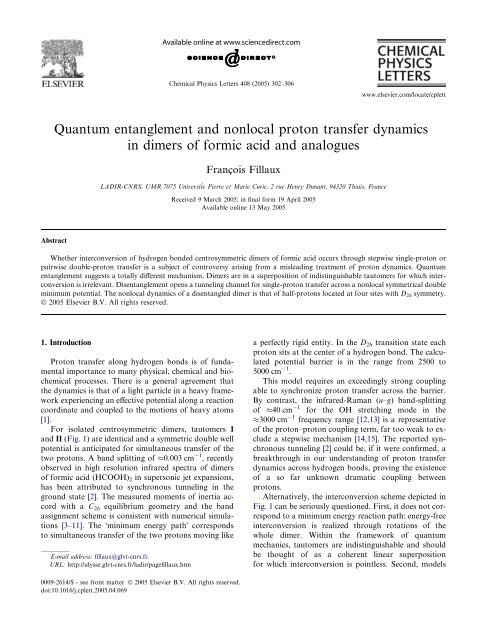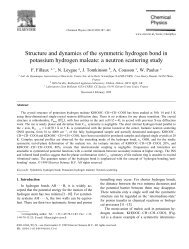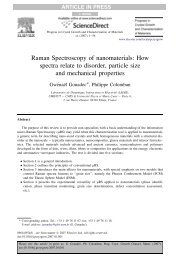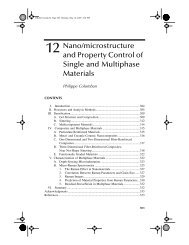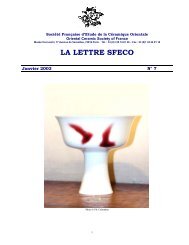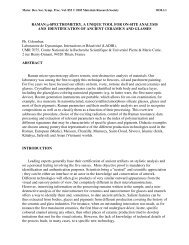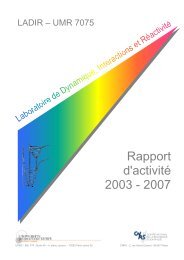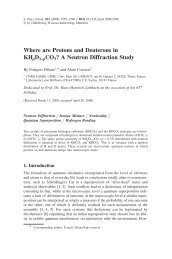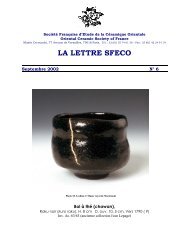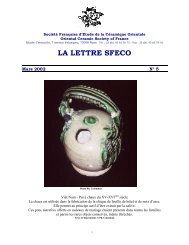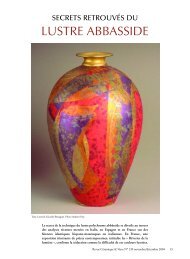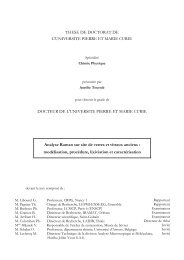Quantum entanglement and nonlocal proton transfer dynamics in ...
Quantum entanglement and nonlocal proton transfer dynamics in ...
Quantum entanglement and nonlocal proton transfer dynamics in ...
You also want an ePaper? Increase the reach of your titles
YUMPU automatically turns print PDFs into web optimized ePapers that Google loves.
Chemical Physics Letters 408 (2005) 302–306www.elsevier.com/locate/cplett<strong>Quantum</strong> <strong>entanglement</strong> <strong>and</strong> <strong>nonlocal</strong> <strong>proton</strong> <strong>transfer</strong> <strong>dynamics</strong><strong>in</strong> dimers of formic acid <strong>and</strong> analoguesFrançois FillauxLADIR-CNRS, UMR 7075 Universit´e Pierre et Marie Curie, 2 rue Henry Dunant, 94320 Thiais, FranceReceived 9 March 2005; <strong>in</strong> f<strong>in</strong>al form 19 April 2005Available onl<strong>in</strong>e 13 May 2005AbstractWhether <strong>in</strong>terconversion of hydrogen bonded centrosymmetric dimers of formic acid occurs through stepwise s<strong>in</strong>gle-<strong>proton</strong> orpairwise double-<strong>proton</strong> <strong>transfer</strong> is a subject of controversy aris<strong>in</strong>g from a mislead<strong>in</strong>g treatment of <strong>proton</strong> <strong>dynamics</strong>. <strong>Quantum</strong><strong>entanglement</strong> suggests a totally different mechanism. Dimers are <strong>in</strong> a superposition of <strong>in</strong>dist<strong>in</strong>guishable tautomers for which <strong>in</strong>terconversionis irrelevant. Dis<strong>entanglement</strong> opens a tunnel<strong>in</strong>g channel for s<strong>in</strong>gle-<strong>proton</strong> <strong>transfer</strong> across a <strong>nonlocal</strong> symmetrical doublem<strong>in</strong>imum potential. The <strong>nonlocal</strong> <strong>dynamics</strong> of a disentangled dimer is that of half-<strong>proton</strong>s located at four sites with D 2h symmetry.Ó 2005 Elsevier B.V. All rights reserved.1. IntroductionProton <strong>transfer</strong> along hydrogen bonds is of fundamentalimportance to many physical, chemical <strong>and</strong> biochemicalprocesses. There is a general agreement thatthe <strong>dynamics</strong> is that of a light particle <strong>in</strong> a heavy frameworkexperienc<strong>in</strong>g an effective potential along a reactioncoord<strong>in</strong>ate <strong>and</strong> coupled to the motions of heavy atoms[1].For isolated centrosymmetric dimers, tautomers I<strong>and</strong> II (Fig. 1) are identical <strong>and</strong> a symmetric double wellpotential is anticipated for simultaneous <strong>transfer</strong> of thetwo <strong>proton</strong>s. A b<strong>and</strong> splitt<strong>in</strong>g of 0.003 cm 1 , recentlyobserved <strong>in</strong> high resolution <strong>in</strong>frared spectra of dimersof formic acid (HCOOH) 2 <strong>in</strong> supersonic jet expansions,has been attributed to synchronous tunnel<strong>in</strong>g <strong>in</strong> theground state [2]. The measured moments of <strong>in</strong>ertia accordwith a C 2h equilibrium geometry <strong>and</strong> the b<strong>and</strong>assignment scheme is consistent with numerical simulations[3–11]. The Ôm<strong>in</strong>imum energy pathÕ correspondsto simultaneous <strong>transfer</strong> of the two <strong>proton</strong>s mov<strong>in</strong>g likeE-mail address: fillaux@glvt-cnrs.fr.URL: http://ulysse.glvt-cnrs.fr/ladir/pagefillaux.htma perfectly rigid entity. In the D 2h transition state each<strong>proton</strong> sits at the center of a hydrogen bond. The calculatedpotential barrier is <strong>in</strong> the range from 2500 to5000 cm 1 .This model requires an exceed<strong>in</strong>gly strong coupl<strong>in</strong>gable to synchronize <strong>proton</strong> <strong>transfer</strong> across the barrier.By contrast, the <strong>in</strong>frared-Raman (u–g) b<strong>and</strong>-splitt<strong>in</strong>gof 40 cm 1 for the OH stretch<strong>in</strong>g mode <strong>in</strong> the3000 cm 1 frequency range [12,13] is a representativeof the <strong>proton</strong>–<strong>proton</strong> coupl<strong>in</strong>g term, far too weak to excludea stepwise mechanism [14,15]. The reported synchronoustunnel<strong>in</strong>g [2] could be, if it were confirmed, abreakthrough <strong>in</strong> our underst<strong>and</strong><strong>in</strong>g of <strong>proton</strong> <strong>transfer</strong><strong>dynamics</strong> across hydrogen bonds, prov<strong>in</strong>g the existenceof a so far unknown dramatic coupl<strong>in</strong>g between<strong>proton</strong>s.Alternatively, the <strong>in</strong>terconversion scheme depicted <strong>in</strong>Fig. 1 can be seriously questioned. First, it does not correspondto a m<strong>in</strong>imum energy reaction path: energy-free<strong>in</strong>terconversion is realized through rotations of thewhole dimer. With<strong>in</strong> the framework of quantummechanics, tautomers are <strong>in</strong>dist<strong>in</strong>guishable <strong>and</strong> shouldbe thought of as a coherent l<strong>in</strong>ear superpositionfor which <strong>in</strong>terconversion is po<strong>in</strong>tless. Second, models0009-2614/$ - see front matter Ó 2005 Elsevier B.V. All rights reserved.doi:10.1016/j.cplett.2005.04.069
F. Fillaux / Chemical Physics Letters 408 (2005) 302–306 303Fig. 1. Interconversion of a dimer of formic acid (HCOOH) 2accord<strong>in</strong>g to [3]. Tautomers I <strong>and</strong> II have C 2h symmetry at equilibrium.The transition state has D 2h symmetry.with<strong>in</strong> the framework of the Born-Oppenheimer approximationare also questionable for the electronic wavefunction is calculated <strong>in</strong> a field of nuclei represented asclassical po<strong>in</strong>t charges. As opposed to this approximation,<strong>proton</strong> tunnel<strong>in</strong>g requires a quantum mechanicaltreatment of nuclei [16].The purpose of this Letter is to rationalize <strong>proton</strong><strong>transfer</strong> <strong>dynamics</strong> <strong>in</strong> terms of quantum <strong>entanglement</strong>–dis<strong>entanglement</strong>, a concept at the heart of the profounddifference between classical <strong>and</strong> quantal physics.2. <strong>Quantum</strong> <strong>entanglement</strong> <strong>in</strong> hydrogen bondedcentrosymmetric dimersThe premises of the theoretical framework for quantum<strong>entanglement</strong> <strong>in</strong> centrosymmetric dimers are thefollow<strong>in</strong>g [17–19].(i) Bridg<strong>in</strong>g <strong>proton</strong>s (deuterons) are <strong>in</strong>dist<strong>in</strong>guishableat the time scale of vibrational <strong>dynamics</strong>.(ii) The time periodic <strong>dynamics</strong> is amenable to normalcoord<strong>in</strong>ates.(iii) The bridg<strong>in</strong>g <strong>proton</strong>s (deuterons) are fermions(bosons) amenable to the symmetry postulate ofquantum mechanics. This is a consequence of theionic character of the hydrogen bond (for exampleHCOO H + ). As opposed to the CH(D) covalentbond, it is allowed to permute bridg<strong>in</strong>g atoms<strong>in</strong>dependently of electrons.(iv) The two <strong>proton</strong>s (deuterons) are degenerate. Theoverlap of the vibrational wave functions is rigorouslynegligible <strong>and</strong> so is the exchange energy [20].Sp<strong>in</strong>–sp<strong>in</strong> <strong>in</strong>teraction is also negligible (10 4 Hz).The vibrational Hamiltonian for a tautomer (say I) isexp<strong>and</strong>ed asH I ¼ H IHðDÞ þ H IM þ H IHðDÞM ;ð1Þwhere H IHðDÞ represents the two <strong>proton</strong>s (deuterons),H IM the molecular frame <strong>and</strong> H IHðDÞM a coupl<strong>in</strong>g betweenthe two subsystems. We temporally ignore theground state degeneracy aris<strong>in</strong>g from the superpositionof I <strong>and</strong> II, <strong>and</strong> concentrate on small amplitude oscillationsaround the mean positions. For the sake of simplicity,rotational <strong>and</strong> rovibrational <strong>dynamics</strong> are not<strong>in</strong>cluded. Therefore, (1) is not <strong>in</strong>tended to provide a detailed<strong>in</strong>terpretation of high resolution spectra. The purposeis limited to <strong>proton</strong> <strong>transfer</strong> <strong>dynamics</strong> for anisotropic probability distribution of dimer orientationsat T =0K.Accord<strong>in</strong>g to (i), the Hamiltonian is <strong>in</strong>variant uponpermutation of <strong>proton</strong>s (deuterons): H IHðDÞM 0. Proton(deuteron) <strong>dynamics</strong> are totally decoupled fromthe molecular frame.Accord<strong>in</strong>g to (ii), <strong>dynamics</strong> are treated with<strong>in</strong> theharmonic approximation. The cartesian axes x, stretch<strong>in</strong>gm OH(D), y, <strong>in</strong>-plane bend<strong>in</strong>g d OH(D), <strong>and</strong> z,out-of-plane bend<strong>in</strong>g c OH(D), are closely parallel tothe <strong>in</strong>ertia axes. Then, the Hamiltonian for two coupledharmonic oscillators <strong>in</strong> three dimensions, labelled 1 <strong>and</strong>2, respectively, located at dist<strong>in</strong>guishable sites,fx 0 0 ; y0 0 ; z0 0 g <strong>and</strong> f x0 0 ; y0 0 ; z0 0g, can be written as[21]H IHðDÞ ¼ X H Ia ; a ¼ x; y; z;aH Ia ¼ 12m P 2 1a þ P 2 1h2a þ2 mx2 0aða 1 a I0 Þ 2 þ ða 2 þ a I0 Þ 2þ2k a ða 1 a 2 Þ 2i . ð2ÞP 1a <strong>and</strong> P 2a are k<strong>in</strong>etic momenta. Coord<strong>in</strong>ates a 1 <strong>and</strong>a 2 are projections onto the a direction of positions, def<strong>in</strong>edwith respect to the center of symmetry. The frequencyof uncoupled oscillators at equilibriumpositions ±a 0 is m 0a = x 0a /(2p). The coupl<strong>in</strong>g potentialproportional to k a depends quadratically on the distancebetween particles. The equilibrium positions ofthe coupled oscillators are shifted at ±a 0 0 ¼a 0 =ð1 þ 4k a Þ. Normal coord<strong>in</strong>ates <strong>and</strong> conjugatedmomenta correspond<strong>in</strong>g to symmetrical <strong>and</strong> antisymmetricaldisplacements,a s ¼ p 1 ffiffi ða 1 a 2 Þ; P sa ¼ p 1 ffiffiffi ðP 1a P 2a Þ;22a a ¼ p 1 ffiffi ða 1 þ a 2 Þ; P aa ¼ p1 ffiffi ðP 1a þ P 2a Þ;22ð3Þsplit H Ia <strong>in</strong>to two orthogonal harmonicpffiffiffiffiffiffiffiffiffiffiffiffiffiffiffioscillators atfrequencies m aa = m 0a <strong>and</strong> m sa ¼ m 0a 1 þ 4k a , respectively,each with an effective mass m:H Ia ¼P 2 aa2m þ 1 2 mx2 0a a2 aþP 2 sa2m þ 1 2 mx2 0a ð1 þ 4k pffiffi 2aÞ a s 2 a0I0þ mx 0a a 2 4k aI0. ð4Þ1 þ 4k a
304 F. Fillaux / Chemical Physics Letters 408 (2005) 302–306This Hamiltonian is a diagonal representation of the<strong>dynamics</strong> but <strong>in</strong>formation on particle positions is lost.In the ground state, the Gaussian wave functionsW a 0 ða aÞ <strong>and</strong> W s 0 ða pffiffiffis 2 a0p I0Þ represent <strong>nonlocal</strong> <strong>dynamics</strong>:a a =0ora s ¼ffiffi2 a0I0do not correspond to any physicallocation of particles. In addition, wave functions cannotbe factored <strong>in</strong>to wave functions for each particle. It is nolonger possible to dist<strong>in</strong>guish particles 1 <strong>and</strong> 2, <strong>and</strong> todecide which particle is at site a 0 0 or a0 0. Particles arefully entangled <strong>in</strong>to EPR-like states [22]. Then, accord<strong>in</strong>gto (iii), we have to dist<strong>in</strong>guish whether the coupledoscillators are bosons (deuterons) or fermions (<strong>proton</strong>s).For deuterons, the state vectors can be written as [21]:jI0 þi D¼jH I0þ ip1 ffiffiX1 X 1S 12 ði; jÞ½j1 : iij2 : jiŠ;6 i¼ 1 jPijI0 i D¼jH I0 ip1 ffiffiX1 X 1A 12 ði; jÞ½j1 : iij2 : jiŠ;3 i¼ 1 j>ið5Þwhere |1:iæ <strong>and</strong> |2:jæ are sp<strong>in</strong> state vectors for particles 1<strong>and</strong> 2, respectively, with i,j = 1,0,1. The symmetric<strong>and</strong> antisymmetric projectors are, respectively,p1ffiffi S 12 ði; jÞ ¼ 2½1 þ P 12 Š; i 6¼ j;1; i ¼ j;<strong>and</strong>ð6Þp1ffiffi A 12 ði; jÞ ¼ 2½1 P 12 Š; i 6¼ j;0; i ¼ j.The permutation operator P 12 is such as:P 12 ½j1 : iij2 : jiŠ ¼ j2 : iij1 : ji.The spatial wave function is"H I0 ¼ p1 ffiffi2 Y aY aW a 0 ða aÞW s 0 ða spffiffiffi2 a0I0 ÞW a 0 ða aÞW s 0 ða ps þffiffi2 a0I0#. Þ ð7ÞFor <strong>proton</strong>s, i,j = ±1/2 <strong>and</strong> the antisymmetrizedstates are:jI0 þi H¼jH I0þ i X1=2i¼ 1=2X 1=2j>iA 12 ði; jÞ½j1 : iij2 : jiŠ;jI0 i H¼jH I0 ip 1 ffiffiX1=2 X 1=2S 12 ði; jÞ½j1 : iij2 : jiŠ.3i¼ 1=2 jPið8ÞAccord<strong>in</strong>g to (iv), <strong>entanglement</strong> occurs at no energycost, apart from the t<strong>in</strong>y sp<strong>in</strong>–sp<strong>in</strong> <strong>in</strong>teraction. At theenergy scale of vibrations, sp<strong>in</strong> states are degenerate.Dynamics of centrosymmetric pairs are <strong>in</strong>tr<strong>in</strong>sicallydecoherence-free with respect to the molecular frame.Although there are many other sources of decoherence,such as collisions, photons, etc., [23], re-<strong>entanglement</strong> occursspontaneously (no energy cost) as long as the twoparticles are <strong>in</strong> the same state (not necessarily the groundstate) <strong>and</strong> the symmetry is preserved. It should be noticedthat the symmetry related sp<strong>in</strong> correlation (8) is totallydifferent <strong>in</strong> nature from the sp<strong>in</strong> states of ortho <strong>and</strong> paraH 2 molecules, which are different chemical entities.3. Tautomerism <strong>and</strong> quantum <strong>entanglement</strong>Let sites at f x 0 0 ; y0 0 ; z0 0 g <strong>and</strong> fx0 0 ; y0 0 ; z0 0g, correspondto II. Eqs. (1)–(8) apply formally upon substitutionof I by II. The bridg<strong>in</strong>g pair is a composed boson<strong>and</strong> a dimer can be represented as a l<strong>in</strong>ear coherentsuperposition analogous to Schröd<strong>in</strong>gerÕCat <strong>in</strong> a superpositionof dead-alive states:j0si ¼p 1 ffiffiffi ½jI0sisjII0siŠ.ð9Þ2Here, s = Ô±Õ. This superposition has C 2h symmetrybut it is totally different <strong>in</strong> nature from the mixture depicted<strong>in</strong> Fig. 1: there is no reaction path for <strong>in</strong>terconversion<strong>in</strong> terms of classical particles mov<strong>in</strong>g alongtrajectories. The ground state is totally degenerate <strong>and</strong>there is no <strong>transfer</strong> <strong>dynamics</strong>. This conclusion makessense for any centrosymmetric dimer, for it is impossibleto prepare, even <strong>in</strong> thought experiments, one tautomerexclusive of the other.A necessary condition for <strong>in</strong>terconversion to occur isdis<strong>entanglement</strong>. This is realized through energy <strong>and</strong>/ormomentum <strong>transfer</strong>. Then, <strong>proton</strong>s k = 1 <strong>and</strong> k = 2 becomedist<strong>in</strong>guishable <strong>and</strong> the disentangled wave functionsfor tautomers are:U Ik0 ¼ Y a kU IIk0 ¼ Y a kW a 0 ða kaÞW s 0 ða ksW a 0 ða kaÞW s 0 ða kspffiffi2 a0I0 Þ;pffiffi2 a0II0 Þ.ð10ÞDis<strong>entanglement</strong> destroys all consequences of the symmetrypostulate while the <strong>nonlocal</strong> nature of the wavefunctions is preserved. Each <strong>proton</strong> (deuteron) is a representativeof the whole <strong>dynamics</strong>. In counter<strong>in</strong>tuitivewords, the <strong>dynamics</strong> of each particle is that of two ÔhalfparticlesÕ,one half at each site of a particular tautomer.Normal coord<strong>in</strong>ates a ka <strong>and</strong> a ks represent anti-phase<strong>and</strong> <strong>in</strong>-phase displacements of these half-particles. Eachtautomer is composed of two such two-half-<strong>proton</strong>ssuperimposed at the same sites. The disentangled wavefunctions for the superposition of tautomers are then:XkU 0þ ¼ p1 ffiffi2U 0 ¼ p1 ffiffiX 2 kðU Ik0 þ U IIk0 Þ;ðU Ik0 U IIk0 Þ.ð11Þ
F. Fillaux / Chemical Physics Letters 408 (2005) 302–306 305Dis<strong>entanglement</strong> removes the ground state degeneracy:the splitt<strong>in</strong>g (E 0 –E 0+ = hm 0t ) is determ<strong>in</strong>ed by theoverlap of U Ik0 <strong>and</strong> U IIk0 , along the m OH coord<strong>in</strong>ate.S<strong>in</strong>ce there is no energy cost, the zero-po<strong>in</strong>t energiesof entangled, |0 + æ, <strong>and</strong> disentangled, |U 0+ æ, states areequal. For each state (11), the two <strong>proton</strong>s are equallydistributed over the four sites. Coherent superpositionof |U 0+ æ <strong>and</strong> |U 0 æ gives rise to oscillations, at frequencym 0t , between tautomers through coherent <strong>transfer</strong> of twohalf-particles, as sketched <strong>in</strong> Fig. 2. The overall balanceis the <strong>transfer</strong> of a <strong>nonlocal</strong> s<strong>in</strong>gle bare <strong>proton</strong> over the<strong>in</strong>ter site distance of 0.7 Å, across a <strong>nonlocal</strong> symmetricaldouble well potential.Accord<strong>in</strong>g to quantum laws, any measurement of<strong>proton</strong> <strong>dynamics</strong> automatically destroys quantum<strong>entanglement</strong>. Therefore, only the disentangled D 2hsymmetry is observable with spectroscopy techniques.However, moments of <strong>in</strong>ertia are identical for the C 2h<strong>and</strong> D 2h structures depicted <strong>in</strong> Fig. 2, as opposed tothose <strong>in</strong> Fig. 1. Therefore, measured moments of <strong>in</strong>ertiaare not conclusive with respect to the actual symmetry.A key issue is to determ<strong>in</strong>e the effective double-wellpotential. The sketch <strong>in</strong> Fig. 2 is so dramatically at variancewith that under consideration <strong>in</strong> theoretical works(Fig. 1) that previously calculated potentials are irrelevant.In addition, the present author is not aware ofany quantum chemistry method able to model <strong>nonlocal</strong><strong>dynamics</strong>.The potential shape can be determ<strong>in</strong>ed from experimentaldata. The double m<strong>in</strong>imum potential splits them OH mode <strong>in</strong> the 3000 cm 1 range <strong>in</strong>to two componentscorrespond<strong>in</strong>g to states |U 1+ æ <strong>and</strong> |U 1 æ, analogousto Eq. (11). Early analysis of the microwave rotationspectra of various carboxylic acid opened-dimers leadto potential barriers of 5000–6000 cm 1 <strong>and</strong> tunnelsplitt<strong>in</strong>g hm 0t 0.5–5 cm 1 for the ground state orhm 1t 50–500 cm 1 for the upper state [24]. For centrosymmetricdimers, the search for tunnel splitt<strong>in</strong>g hasbeen hampered by the prevail<strong>in</strong>g op<strong>in</strong>ion that the <strong>transfer</strong>of a s<strong>in</strong>gle <strong>proton</strong> yields an unrealistic complex composedof a de-<strong>proton</strong>ated carboxylic group bound to adi-<strong>proton</strong>ated one. Nevertheless, Robertson <strong>and</strong> Lawrence[25] have shown that <strong>in</strong>frared spectra of the formicacid dimer are consistent with a symmetrical doublem<strong>in</strong>imum potential with hm 0t 1.5 cm 1 , hm 1t 140 cm 1 , <strong>and</strong> H 6400 cm 1 . However, ow<strong>in</strong>g tothe manifold of b<strong>and</strong> splitt<strong>in</strong>g mechanisms, the assignmentscheme of the OH stretch<strong>in</strong>g b<strong>and</strong>s is controversial.To the best of the present authorÕs knowledge,observation of hm 0t has never been reported <strong>and</strong> more<strong>in</strong>formation is necessary to corroborate this assignmentscheme.Quite similar effective potentials have been obta<strong>in</strong>edfor s<strong>in</strong>gle-<strong>proton</strong> <strong>transfer</strong> <strong>in</strong> crystals composed ofhydrogen bonded centrosymmetric dimers. For potassiumhydrogencarbonate(KHCO 3 ) hm 0t =17cm 1 ,hm 01 = 130 cm 1 , <strong>and</strong> H = 4850 cm 1 [26,27]. For benzoicacid hm 0t =6cm 1 , hm 01 = 100 cm 1 , <strong>and</strong>H = 5000 cm 1 [28]. These values corroborate theassignment scheme of Robertson <strong>and</strong> Lawrence. Tothe least, a tunnel splitt<strong>in</strong>g of 0.003 cm 1 for the formicacid dimer [2] is quite out of range. Hopefully, thepresent Letter will be an <strong>in</strong>centive to seek tunnel splitt<strong>in</strong>g<strong>in</strong> the 1–10 cm 1 region.4. ConclusionNonlocality <strong>and</strong> quantum <strong>entanglement</strong> could be ofcentral importance to <strong>proton</strong> <strong>transfer</strong> <strong>dynamics</strong>, butthese concepts have been overlooked <strong>in</strong> previous works.With h<strong>in</strong>dsight, this is surpris<strong>in</strong>g s<strong>in</strong>ce wave functionsfor normal coord<strong>in</strong>ates are <strong>nonlocal</strong> representation of<strong>dynamics</strong>, logically amenable to <strong>entanglement</strong>. Thesymmetry related <strong>entanglement</strong> is extremely robust:environment or measurement <strong>in</strong>duced decoherence iscont<strong>in</strong>uously counterbalanced by spontaneous re-<strong>entanglement</strong>at no energy cost. This leads to noncommonsensicalconclusions <strong>in</strong>dependent of the systemenergetics.Indist<strong>in</strong>guishability <strong>and</strong> quantum <strong>entanglement</strong> imposeperfect correlation of the two particles (either <strong>proton</strong>sor deuterons), irrespective of coupl<strong>in</strong>g terms. Anentangled dimer is a coherent superposition of tautomers(Schröd<strong>in</strong>gerÕCat) <strong>and</strong> <strong>in</strong>terconversion is mean<strong>in</strong>gless.Dis<strong>entanglement</strong> opens a tunnel<strong>in</strong>g channel forthe <strong>transfer</strong> of <strong>nonlocal</strong> entities with an effective massof 1 a.m.u. (two half-<strong>proton</strong>s) across a <strong>nonlocal</strong> doublem<strong>in</strong>imum potential. This is a nonstatistical manifestationof quantum <strong>nonlocal</strong>ity.Fig. 2. Dynamics of <strong>in</strong>dist<strong>in</strong>guishable nonseparable dimers. Thesystem oscillates between a superposition of C 2h entangled tautomersI <strong>and</strong> II <strong>in</strong> the ground state (a), <strong>and</strong> D 2h disentangled dimers (excitedstate at hm 0t ) with a half-<strong>proton</strong> at each site (b).References[1] S. Sche<strong>in</strong>er, Hydrogen Bond<strong>in</strong>g: A Theoretical Perspective,Oxford University Press, Oxford, 1997.[2] F. Madeja, M. Havenith, J. Chem. Phys. 117 (2002) 7162.
306 F. Fillaux / Chemical Physics Letters 408 (2005) 302–306[3] Y. Kim, J. Am. Chem. Soc. 118 (1996) 1522.[4] S. Hayashi, J. Unemura, S. Kato, K. Morokuma, J. Phys. Chem.88 (1984) 1330.[5] Y.T. Chang, Y. Yamaguchi, W.H. Miller, H.F. Schaefer III,J. Am. Chem. Soc. 109 (1987) 7245.[6] N. Shida, P.F. Barbara, J. Almlöf, J. Chem. Phys. 94 (1991) 3633.[7] M.V. Vener, O. Kühn, J.M. Bowman, Chem. Phys. Lett. 349(2001) 562.[8] C.S. Tautermann, A.F. Voegele, K.R. Liedl, J. Chem. Phys. 120(2004) 631.[9] Z. Smedarch<strong>in</strong>a, A. Fern<strong>and</strong>ez-Ramos, W. Siebr<strong>and</strong>, Chem.Phys. Lett. 395 (2004) 339.[10] P.R.L. Markwick, N.L. Dolts<strong>in</strong>is, D. Marx, J. Chem. Phys. 122(2005) 054112.[11] Z. Smedarch<strong>in</strong>a, A. Fern<strong>and</strong>ez-Ramos, W. Siebr<strong>and</strong>, J. Chem.Phys. 122 (2005) 134309.[12] J.E. Bertie, K.H. Michaelian, J. Chem. Phys. 76 (1982) 886.[13] J.E. Bertie, K.H. Michaelian, H.H. Eysel, D. Hager, J. Chem.Phys. 85 (1986) 4779.[14] B.S. Jursic, J. Mol. Struct. (Theochem) 417 (1997) 89.[15] H. Ushiyama, K. Takatsuka, J. Chem. Phys. 115 (2001) 5903.[16] M.V. Pak, S. Hammes-Schiffer, Phys. Rev. Lett. 92 (2004) 103002.[17] F. Fillaux, Physica D 113 (1998) 172.[18] S. Ikeda, F. Fillaux, Phys. Rev. B 59 (1999) 4134.[19] F. Fillaux, A. Cousson, D. Keen, Phys. Rev. 67 (2003) 054301,<strong>and</strong> 189901(E).[20] F. Fillaux, A. Cousson, J. Phys.:Condens. Matter 16 (2004)1007.[21] C. Cohen-Tannoudji, B. Diu, F. Laloë, Mécanique Quantique,Hermann, Paris, France, 1977.[22] A. E<strong>in</strong>ste<strong>in</strong>, B. Podolsky, N. Rosen, Phys. Rev. 47 (1935) 777.[23] W.H. Zurek, Rev. Mod. Phys. 75 (2003) 715.[24] C.C. Costa<strong>in</strong>, G.P. Srivastava, J. Chem. Phys. 41 (1964) 1620.[25] G.N. Robertson, M.C. Lawrence, Chem. Phys. 62 (1981) 131.[26] F. Fillaux, Chem. Phys. 74 (1983) 405.[27] F. Fillaux, J. Tomk<strong>in</strong>son, J. Penfold, Chem. Phys. 124 (1988) 425.[28] F. Fillaux, M.-H. Limage, F. Roma<strong>in</strong>, Chem. Phys. 276 (2002)181.


